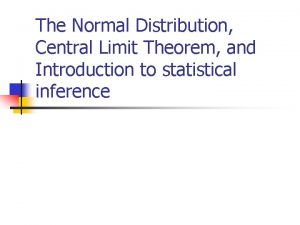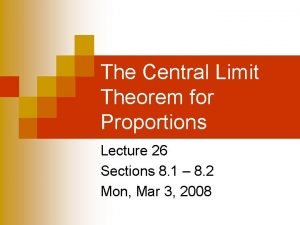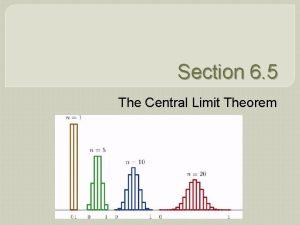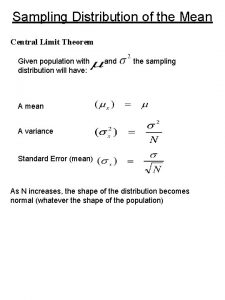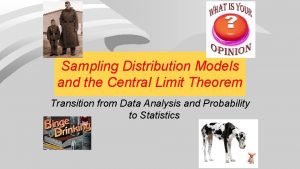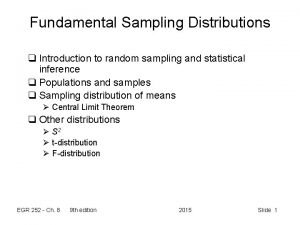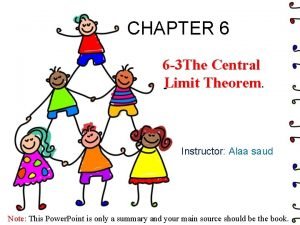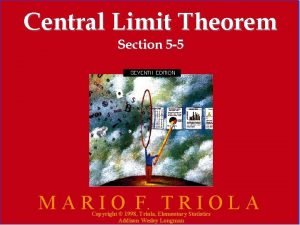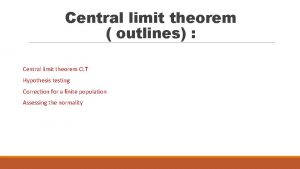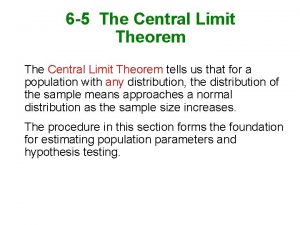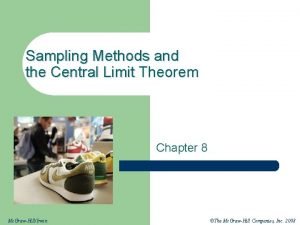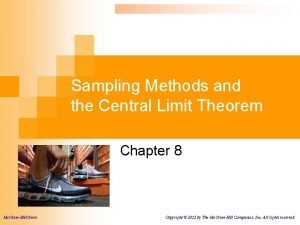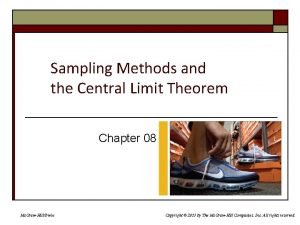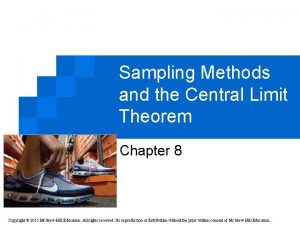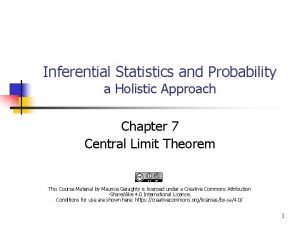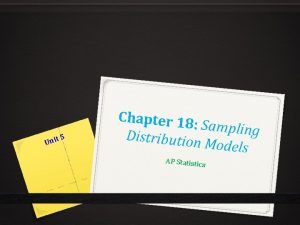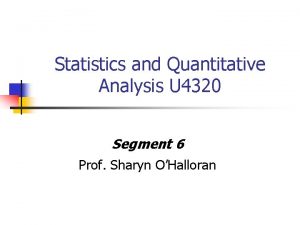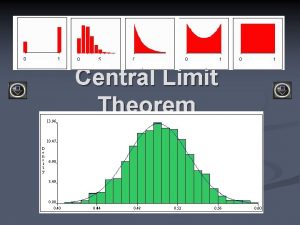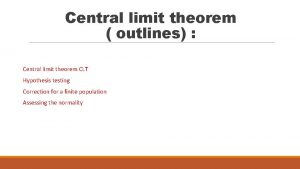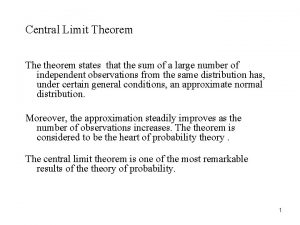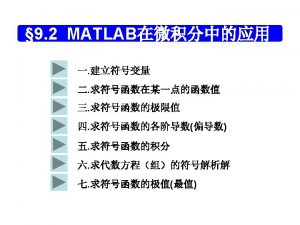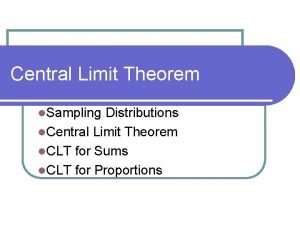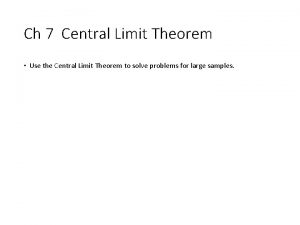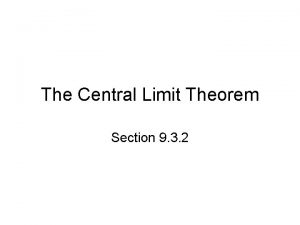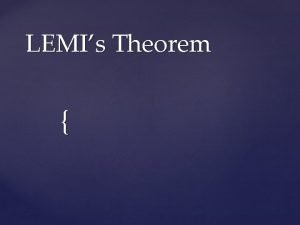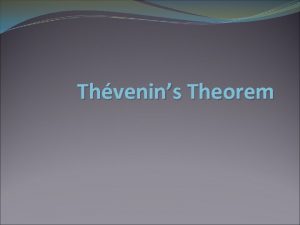Central Limit Theorem Section 5 5 M A




















- Slides: 20

Central Limit Theorem Section 5 -5 M A R I O F. T R I O L A Copyright © 1998, Triola, Elementary Statistics Addison Wesley Longman 1

As the sample size increases the distribution of sample means will approach a normal distribution. Copyright © 1998, Triola, Elementary Statistics Addison Wesley Longman 2

Distribution of 200 digits From Social Security Numbers Frequency (Last 4 digits from 50 students) 20 10 0 0 1 2 3 4 5 6 7 8 9 Distribution of 200 digits Figure 5 -19 Copyright © 1998, Triola, Elementary Statistics Addison Wesley Longman 3

Table 5 -1 x SSN digits 1 5 9 4 7 9 5 7 8 3 8 1 3 2 7 1 3 83 2 6 2 2 5 0 2 7 8 5 7 7 3 4 4 4 5 1 3 6 6 3 8 2 3 6 1 5 3 42 6 7 3 3 8 3 7 6 4 6 8 5 5 2 6 4 9 4. 75 4. 25 8. 25 3. 25 5. 00 3. 50 5. 25 4. 75 5. 00 2 6 1 9 5 7 8 6 4 0 7 4. 00 5. 25 4. 50 4. 75 3. 75 5. 25 3. 75 4. 50 6. 00 Copyright © 1998, Triola, Elementary Statistics Addison Wesley Longman 4

Frequency Distribution of 50 Sample Means for Students 15 10 5 0 0 1 2 3 4 5 6 7 8 9 Distribution of 50 Sample Means Figure 5 -20 Copyright © 1998, Triola, Elementary Statistics Addison Wesley Longman 5

Normal, Uniform, and Skewed Distributions Figure 5 -24 Normal Uniform Skewed Original population Sample means (n=5) Sample means ( n = 10 ) Sample means ( n = 30 ) Copyright © 1998, Triola, Elementary Statistics Addison Wesley Longman 6

Normal, Uniform, and Skewed Distributions Figure 5 -24 Normal Uniform Original population Sample means (n=5) Sample means ( n = 10 ) Sample means ( n = 30 ) Copyright © 1998, Triola, Elementary Statistics Addison Wesley Longman 7

Normal, Uniform, and Skewed Distributions Figure 5 -24 Normal Uniform Skewed Original population Sample means (n=5) Sample means ( n = 10 ) Sample means ( n = 30 ) Copyright © 1998, Triola, Elementary Statistics Addison Wesley Longman 8

Central Limit Theorem Given: 1. The random variable x has a distribution (which may or may not be normal) with mean µ and standard deviation s. 2. Samples of size population. n are randomly selected from this Copyright © 1998, Triola, Elementary Statistics Addison Wesley Longman 9

Central Limit Theorem Given: 1. The random variable x has a distribution (which may or may not be normal) with mean µ and standard deviation s. 2. Samples of size population. n are randomly selected from this Conclusions: Copyright © 1998, Triola, Elementary Statistics Addison Wesley Longman 10

Central Limit Theorem Given: 1. The random variable x has a distribution (which may or may not be normal) with mean µ and standard deviation s. 2. Samples of size population. n are randomly selected from this Conclusions: 1. The distribution of sample means x will, as the sample size increases, approach a normal distribution. Copyright © 1998, Triola, Elementary Statistics Addison Wesley Longman 11

Central Limit Theorem Given: 1. The random variable x has a distribution (which may or may not be normal) with mean µ and standard deviation s. 2. Samples of size population. n are randomly selected from this Conclusions: 1. The distribution of sample means x will, as the sample size increases, approach a normal distribution. 2. The mean of the sample means will be the population mean µ. s 3. The standard deviation of the sample means will be — n Copyright © 1998, Triola, Elementary Statistics Addison Wesley Longman 12

Practical Rules Commonly Used : 1. For samples of size n larger than 30, the distribution of the sample means can be approximated reasonably well by a normal distribution. The approximation gets better as the sample size n becomes larger. 2. If the original population is itself normally distributed, then the sample means will be normally distributed for any sample size n. Copyright © 1998, Triola, Elementary Statistics Addison Wesley Longman 13

Notation Copyright © 1998, Triola, Elementary Statistics Addison Wesley Longman 14

Notation the mean of the sample means µx = µ the standard deviation of sample mean sx = s n (often called standard error of the mean) Copyright © 1998, Triola, Elementary Statistics Addison Wesley Longman 15

Notation the mean of the sample means µx = µ the standard deviation of sample means sx = s n (often called standard error of the mean) Copyright © 1998, Triola, Elementary Statistics Addison Wesley Longman 16

Notation the mean of the sample means µx = µ the standard deviation of sample mean sx = s n (often called standard error of the mean) Copyright © 1998, Triola, Elementary Statistics Addison Wesley Longman 17

Sampling Without Replacement If n > 0. 05 N Copyright © 1998, Triola, Elementary Statistics Addison Wesley Longman 18

Sampling Without Replacement If n > 0. 05 N s sx = n N– 1 Copyright © 1998, Triola, Elementary Statistics Addison Wesley Longman 19

Sampling Without Replacement If n > 0. 05 N s sx = n N– 1 finite population correction factor Copyright © 1998, Triola, Elementary Statistics Addison Wesley Longman 20
 Central limit theorem standard error
Central limit theorem standard error Central limit theorem equation
Central limit theorem equation Rules of central limit theorem
Rules of central limit theorem Mean of sampling distribution
Mean of sampling distribution Central limit theorem
Central limit theorem Onlinestatbook central limit theorem
Onlinestatbook central limit theorem Central limit theorem formula
Central limit theorem formula Rules of central limit theorem
Rules of central limit theorem Central limit theorem
Central limit theorem Rules of central limit theorem
Rules of central limit theorem Sampling methods and the central limit theorem
Sampling methods and the central limit theorem Sampling methods and the central limit theorem
Sampling methods and the central limit theorem Sampling methods and the central limit theorem
Sampling methods and the central limit theorem Limit sample
Limit sample Central limit theorem probability
Central limit theorem probability Central limit theorem conditions
Central limit theorem conditions Sharyn o'halloran
Sharyn o'halloran Laplace biography
Laplace biography Stock theorem
Stock theorem Upper specification limit and lower specification limit
Upper specification limit and lower specification limit Natural variations operations management
Natural variations operations management
